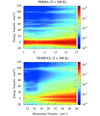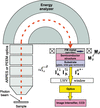issue contents
May 2021 issue

Cover illustration: Concept of large field of view pixel super-resolution scanning transmission hard X-ray microscopy based on an array of inclined biconcave parabolic refractive multi-lenses (RMLs). SEM images of the fabricated nickel RMLs. (see Mamyrbayev, Ikematsu, Takano, Wu, Kimura, Doll, Last, Momose and Meyer, pages 732–740).
facility information
research papers
A new seed laser-assisted microbunching generation method has been proposed. This method can be used to produce femtosecond coherent radiation in a laser-plasma accelerator-based light source.
A numerical study of the effect of betatron oscillations on the second harmonic generation in free-electron lasers (FELs) is presented. A program for FEL simulation with new analytical expressions is developed; the modeling of harmonics in LCLS and PAL-XFEL experiments is performed.
Open  access
access
 access
accessThe high-precision X-ray diffraction (XRD) setup for work with diamond anvil cells (DACs) in Interaction Chamber 2 of the High Energy Density (HED) instrument of the European X-ray Free-Electron Laser is described.
Open  access
access
 access
accessThe design of a soft X-ray free-electron laser for the SXL project at the MAX IV Laboratory is presented.
Open  access
access
 access
accessThe 3 GeV electron storage ring of the MAX IV laboratory is the first light source storage ring that has the inner surface of nearly all the vacuum chambers coated with non-evaporable getter (NEG) thin film. The vacuum and the accelerator performance have proven successful.
Open  access
access
 access
accessA new X-ray focusing device generates hundreds of thousands of line foci, periodically spaced in the sub-micrometre range, with centimetre length. It enables to achieve large FOV pixel super-resolution scanning transmission hard X-ray microscopy.
A mathematical apparatus for solving problems of X-ray wave propagation through complex optical systems, when the lens thickness can change with jumps, is developed and presented.
Temperature-gradient analyzers for medium resolution, 25–32 meV, non-resonant inelastic X-ray scattering are fabricated and evaluated.
Open  access
access
 access
accessSpatial frequency radiation properties from a step-wise magnetic structure of an undulator are studied. This magnetic scheme is the most suitable for the superconducting undulators and provides the radiation properties that facilitate developing future beamlines dedicated to micro-probing.
Open  access
access
 access
accessThe application of a microfluidic cell, specifically optimized for low penetrating soft X-ray radiation, as a dosimetry cell is reported. An analysis of the important parameters of the microfluidic cell, as well as their influences over dosimetry, is also reported. Measurements at 1.28 keV led to the determination of a hydroxyl production yield, G(HO.), of 0.025 ± 0.004 µmol J−1.
Open  access
access
 access
accessThe first reported in-situ synchrotron X-ray diffraction experiments for the inertia friction welding process are presented. The evolution of the microstructure around the weld interface has been quantified throughout the process.
Several different methods of measuring the energy resolution for meV-resolved inelastic X-ray scattering are investigated. Quantitative determination of inelastic contributions to the scattering from plexiglass and borosilicate glass enables an efficient, single scan, approach to resolution determination for a large (4 × 7) array of analyzers.
Open  access
access
 access
accessHardware and software for anomalous small-angle X-ray scattering on biological macromolecules in solution implemented at the P12 beamline of the EMBL (PETRA III storage ring, DESY, Hamburg) are described.
Open  access
access
 access
accessThis compact, Creative-Commons-licensed ultra-SAXS module, augments existing high-performance SAXS/WAXS synchrotron instruments, so that larger structures may be measured. Its functionality is demonstrated at the I22 beamline at Diamond Light Source, where the combined USAXS/SAXS/WAXS range of an alumina membrane, a porous carbon catalyst and silica, covers over four decades in scattering angle.
A general method for calculating the dose absorbed in X-ray irradiation of a material when the irradiation changes the physical properties of the material is presented. The method considers cases where X-ray irradiation alters the chemical structure, the amount of material in the irradiated area, the linear absorption coefficient and the density of the material.
The photocatalytic oxidation of As(III) to less toxic As(V) by TiO2 nanotubes studied using in situ synchrotron X-ray absorption spectroscopy is presented.
A generalized reverse projection method has been established analytically for grating-based phase tomography with non-uniform reference. The method combines the advantages of the high efficiency of the reverse projection method and the universal applicability of the phase-stepping method.
The concept of an imaging-type 3D spin detector, based on the combination of spin-exchange interactions in the ferromagnetic film and spin selectivity of the electron–photon conversion effect (cathodoluminescence) in a semiconductor heterostructure, is proposed and demonstrated on a model system.
Open  access
access
 access
accessHere, streak noise is modeled in the sinogram domain as correlated noise, which is attenuated by the Block-Matching and 3-D (BM3D) filtering algorithm applied across multiple scales. The proposed procedure is fully automatic and attenuates streak noise and the corresponding ring artifacts without creating major distortions common to other streak removal algorithms.
Open  access
access
 access
accessAutomatic segmentation methods developed for tomography data collected on macromolecular crystallography beamline I23, Diamond Light Source, to assist with absorption corrections for very long wavelengths X-ray diffraction data are presented.
The effect of coherence properties on EUV-IL is analysed to obtain high-quality patterns using the mutual optical intensity model.
A parameter estimation method based on the deep learning CNN-LSTM model is proposed for overlapping nuclear pulses shaped by several exponential decay nuclear pulses.
short communications
A refraction correction for grazing-incidence X-ray diffraction has been developed that can be applied to buried interfaces, including liquid–solid interfaces, allowing for a more quantitative determination of d-spacing values.
Open  access
access
 access
accessThe presented 3D dual-energy focal stacks imaging method enables different elements in a sample to be quickly distinguished or certain elements of interest to be obtained.
beamlines
Open  access
access
 access
accessThe new TPS 44A beamline at the Taiwan Photon Source is presented. The beamline is equipped with a new quick-scanning monochromator (Q-Mono), which can provide both conventional step-by-step scans and on-the-fly scans for XAFS spectroscopy experiments, including XANES and EXAFS spectral measurements.
Open  access
access
 access
accessBeamline I22, a versatile SAXS/WAXS beamline at Diamond Light Source, is presented, along with an overview of 10 years operation of the beamline.
Open  access
access
 access
accessThe KMC-3 XPP endstation of the synchrotron BESSY II is dedicated to time-resolved studies of structural dynamics of matter upon optical and/or electrical excitation using hard X-ray diffraction with an accessible time range from 17 ps to several microseconds.
A description of a new hard X-ray diffraction beamline for materials science at the Canadian Light Source is presented.
Open  access
access
 access
accessPROXIMA-1 at Synchrotron SOLEIL has been run for 12 years as an endstation dedicated to macromolecular crystallography experiments, optimized for anomalous data recording and diffraction studies of large unit-cell crystals.
Open  access
access
 access
accessThe development of a high-resolution and highly efficient beamline for soft X-ray resonant inelastic X-ray scattering (RIXS) located at the Taiwan Photon Source is reported.
Open  access
access
 access
accessA timing scheme for single-pulse holographic pump–probe imaging at the MID instrument at the European XFEL is presented and characterized.
Open  access
access
 access
accessA UHV-compatible MOKE magnetometer for in situ studies operating in tandem with the PEEM at the Nanospectroscopy beamline of the Elettra synchrotron.
Open  access
access
 access
accessThe design and operational performance of beamline I14, the Hard X-ray Nanoprobe at Diamond Light Source, is presented.
teaching and education
Open  access
access
 access
accessA new teaching strategy presents synchrotron sources and free-electron lasers (FELs) in a form accessible to readers without a theoretical physics background. This specifically includes the microbunching and amplification mechanisms of FELs.
addenda and errata
Open  access
access
 access
access

 journal menu
journal menu

























































